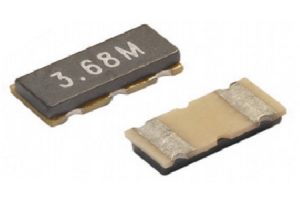Enhance Your Electronics Projects with Ceramic Resonator
What exactly is a ceramic resonator?
- An electrical component known as a ceramic resonatoris utilized in electronic circuits to produce accurate and steady frequencies. In terms of how it works, it is comparable to a quartz crystal resonator; however, it is constructed of ceramic materials rather than quartz.
- A ceramic substrate with metal electrodes inserted makes up a ceramic resonator. The resonator’s ceramic material is piezoelectric, implying that it may produce an electric charge when mechanically distorted. The ceramic resonator vibrates at a certain frequency set by the resonator’s physical characteristics and material composition when an electrical signal is supplied to the metal electrodes.
- Electronic circuits like timing and oscillator circuits that need precise and reliable frequency references frequently employ ceramic resonators. Compared to quartz crystal resonators, they are often smaller and less costly, although they could have less precision and frequency stability. Nevertheless, ceramic resonators are frequently adequate for many applications where great accuracy is optional.
How do Ceramic Resonators Perform?
These resonators utilize the piezoelectric effect to provide a steady oscillation signal. The resonator’s ceramic material is carved into a certain form, such as a disc or cylinder, and then covered on both sides with metal electrodes. A steady oscillation signal is generated when an alternating voltage is supplied between the electrodes, causing the ceramic material to oscillate at a certain frequency. The physical properties of the ceramic material and the resonator’s form control the oscillation signal’s frequency. The frequency may be changed to suit the needs of the electronic circuit by selecting the proper ceramic material and resonator form.
The Effectiveness of Ceramic Resonators:
The ceramic resonator is an electrical component used in various electronic devices, including oscillators, filters, and timing circuits. Compared to other kinds of resonators, they have several advantages, such as:
- Cost-effectiveness:
Compared to other resonator types, such as quartz crystal oscillators, resonators are often more affordable. Because of this, they are a desirable solution for applications where the price is a key factor.
- Small size:
These resonators are available in small sizes, making them appropriate for use in electrical devices that are small and portable. They are perfect for applications requiring less room due to their tiny size.
- High level of dependability:
These resonators have a high level of dependability and can function in various temperatures and environmental situations. They do not experience the effects of ageing and have a long service life.
- Utilization:
Ceramic resonators require few external components and are simple to utilize. They are thus perfect for use in straightforward electrical circuits. They have a stable frequency across a large temperature range, making them a good choice for applications where precise timing is important.
What is the role of ceramic resonators in wireless communication applications?
The ability to modulate and demodulate signals using steady and precise reference frequencies is one of the key functions of ceramic resonators in wireless communication applications. Mobile phones, routers, and modems often employ them in various wireless communication equipment.
The ceramic resonator is essential for effective operation:
Creating reliable clock signals for the microcontrollers and digital signal processors (DSPs) that manage the functions of these devices is one of the main uses of ceramic resonators in wireless communications. Ceramic resonators provide a stable and reliable reference frequency for generating these clock signals, which is critical for the efficient operation of these devices as precise timing of the clock signals is required. The use of ceramic resonators in wireless communication systems also helps reduce phase noise and jitter of signals, thereby improving signal quality and improving device performance. Additionally, ceramic resonators have excellent temperature stability, which is critical to maintaining frequency accuracy over a wide operating temperature range. Furthermore, filters and oscillators in wireless communication circuits are designed using ceramic resonators. They are commonly used in oscillators to generate the frequencies needed for signal transmission and reception, and in resonant circuits of RF filters to adjust the filter’s frequency response.
Microcontroller applications for ceramic resonators:
Microcontrollers frequently employ ceramic resonators because they give the device a reliable and precise clock signal. The microcontroller’s activities are synchronized using the clock signal to ensure they are completed precisely and effectively. We will go through a few of the uses for ceramic resonators in microcontrollers in this post.
- Real-Time Clocks:
The reference clock for the microcontrollers’ real-time clock (RTC) module is frequently a ceramic resonator. Using the ceramic resonator’s reference clock, the RTC module keeps track of the date and time even when the microcontroller is off. This is helpful in applications like data loggers, timers, and alarm systems that demand precise timekeeping.
- Interfaces for Communications:
Microcontrollers with communication interfaces like UART, SPI, and I2C also employ ceramic resonators. The ceramic resonator’s precise clock signal guarantees the data is sent and received at the right baud rate, ensuring dependable and error-free communication.
- Motor Skills:
Ceramic resonators provide exact timing for the PWM signals that regulate the motor speed and direction in applications that need precision motor control, such as robotics and automation. The ceramic resonator’s precise timing ensures the motor operates smoothly and effectively.
- Uses for Sensors:
Microcontrollers with analogue-to-digital converters (ADCs) and digital-to-analogue converters (DACs) for sensor applications also employ ceramic resonators. As the analogue signals are sampled and converted to digital signals at the proper rate, thanks to the ceramic resonator’s precise clock signal, the sensor data may be measured with accuracy and reliability.
- Power Administration:
Microcontrollers with power management capabilities like sleep and low-power modes also employ ceramic resonators. The ceramic resonator’s precise clock signal guarantees that the microcontroller enters sleep mode at the appropriate moment, saving power and prolonging battery life.
Conclusion
The ceramic resonator is essential in microcontroller applications because they supply a precise and consistent reference clock signal that guarantees the microcontroller’s dependable and effective performance. Real-time clocks, communications interfaces, motor control, sensor applications, and power management are just a few of the many uses for them. To fulfil the demands of various clients, including original equipment manufacturers, original design manufacturers, and electronic manufacturing service providers, ChipSun Technologies offers R&D solutions, turnkey solutions, e-commerce, and other value-added services.

